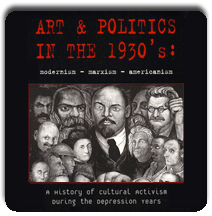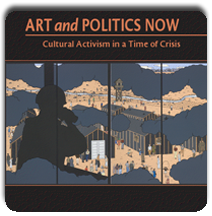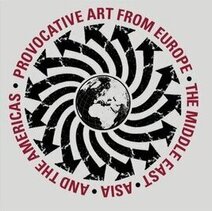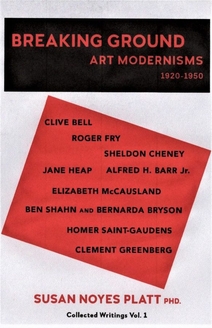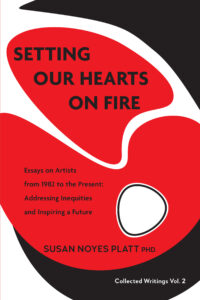Thaddeus Moseley and Alexander Calder
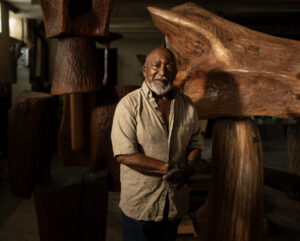
First, we think that these two artists, Alexander Calder and Thaddeus Mosley, could not possibly be more dissimilar in this new iteration of the Calder donation curated by Catherina Manchanda. “Following Space,” the title of their joint exhibition at the Seattle Art Museum, captures the central feeling of the exhibition. As we walk through the galleries, we do indeed feel we are following the spaces that both of these artists carve and cut and slice in their sculptures. But how different they are!
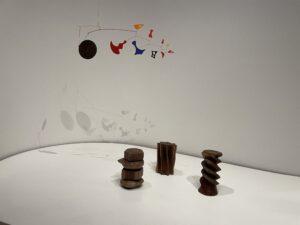
Calder’s mobiles are light and constantly moving with many small pieces of metal hanging from fragile wires. Mosley’s work is heavy, made of chiseled tree trunks. Calder uses industrial materials like sheet metal, Mosley uses only wood, Calder emphasizes lines created by wire and light shapes of metal, Mosley chisels carefully on solid shapes.

But we must look again at this provocative pairing. In the first gallery we see White Panel 1936 by Alexander Calder and First Port, 2008, by Mosley. Calder’s work descends from on high, while Mosley’s work reaches up. The carefully chiseled wood creates a sense of liberating the wood from itself. Following Space, 2016 in the center of the gallery, gives the exhibition its title, and is even more clearly rising up from its base.
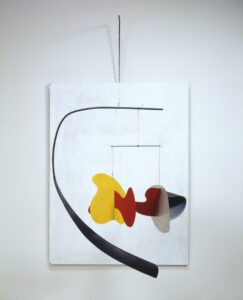

Mosley works with wood that he finds in the forest, cherry and walnut. The wood is chiseled carefully to highlight the given shape of the log, then he connects separate pieces by inserting it into a notch or large hole in the wood. This use of notches means that the pieces balance with no outside support, unlike Calder’s mobiles which balance with carefully calculated lengths of wire and the weight of the small pieces of metal. Calder’s mobiles seem to almost flutter like clouds sometimes.
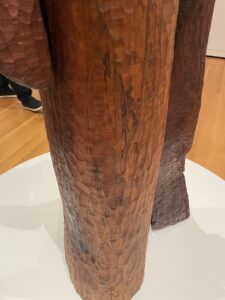

Mosley is entirely self- taught, his rhythms drawn from jazz seen in the abstraction of his shapes. But he has also looked at African sculpture from Dogon, Senufo, Banum and Mossi. He has his own collection of African sculpture. The African artists also carved wood with many different results. Often they were figurative, but also they sometimes allowed the shape of the wood to speak on its own, making an abstract shape. Mosley also learned from looking at Giacometti and Brancusi who work in bronze and stone. Mosley’s work brings together these inspirations in an original composition in wood.
Some of Mosley’s pieces seem to sit solidly on the ground, like Oval Continuity, 2017 that appears to be a carefully cut large oval ball. But the more we look at it, the more we feel it is about to burst forth into some magnificent vertical shape. Next to Mosley’s Oval Continuity is Calder’s Bougainvillea, 1947. It has a base on the ground, but it bursts forth in delicate flowers in all directions.

Other examples of pieces that appear to be grounded, but also rise up are Little Escalation, 2018 and Bended, 2018 (center and right in picture). They are single pieces of wood, with no insertions or extensions, but they too seem to be straining upward with an accordion pleat or a twist.

Mosley is 99 years old! He has been making sculpture since the 1950s. But only in the last few years has he achieved real recognition. He readily admits that is because he is Black. The current situation for artists of color is more open and accepting. But if we were to see one of these muscular sculptures without knowing the artist, we would still be overwhelmed by their beauty: the artist’s respect for wood as a material shines through as we look at his careful chisel marks and his surprising shapes and juxtapositions. It is sometimes tempting to anthropomorphize his shapes, an animal, a bird, a face, but look again and it is gone.
Fortunately, you have time to see this show, (it ends on June 1) but don’t put it off. I have been three times and each time I experienced it entirely differently. Hats off to Catharina Manchanda for this wonderful idea.

This entry was posted on February 3, 2025 and is filed under Uncategorized.


